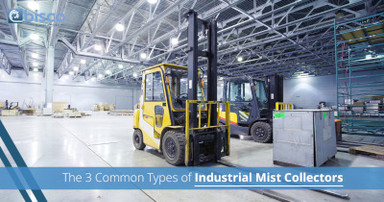Aug 15th 2017
The Fundamentals of Mist Collection, Part One
If you’re in the metalworking or welding industry, you’ve probably already heard about the importance of mist collectors in your facility. Warehouses and factories utilize mist collection systems to help provide clean air and to reduce the adverse effects of the hazards of metalworking fluids. Not only do these machines help companies comply with indoor air quality standards, they can help to reduce maintenance and housekeeping costs while also improving part quality. At Bisco Enterprise, we’re proud to be a leading provider of air cleaning and mist collection systems and we love educating our clients on the array of products available. If you need assistance choosing the best mist collection system for your welding or metalworking business, contact our experts today!
Mist & Smoke Collection Systems
While it may be hard to believe, some manufacturers think that if they can’t see the mist or smoke in their warehouse, it doesn’t exist. This view does not acknowledge the damage submicron mist and smoke can have on the manufacturing environment. Before we go into detail on the performance characteristics of mist, let’s examine how mist and smoke are generally defined.
Mist can be described as a liquid droplet that is around 20 microns in diameter or smaller. In oil based and water soluble lubricants and coolants, mist can be found to generate in a variety of applications including metal cutting, metal forming, and grinding, among others. Smoke, on the other hand, is typically a much smaller material in size, ranging from 0.07 microns to one micron in diameter. Smoke can either come in the form of a solid or liquid aerosol. This can be a result of incomplete combustion or the condensation of a supersaturated vapor.
It’s important to note that mist and smoke can have a negative effect on maintenance and housekeeping, employee health, and even compliance with indoor air quality or emissions standards. Even though the human eye cannot see droplets smaller than 40 microns, these dangers exist in a variety of applications.
Mist Collection & Performance Characteristics

As you may already know, a mist collector’s main function is to effectively remove mist and smoke droplets from the filtered air stream. In order to accomplish this task, a collector must coalesce small drops into larger ones and then drain the collected coolant from the filters before the plug. There are three measurable properties of a mist collection system, which include:
Pressure Drop
The operating pressure drop of your mist collection system is a very important part of the energy cost equation for your facility. A higher pressure drop means that more energy is required to pull airflow through the collector.
Efficiency
The efficiency of the mist collector’s ability to remove mist and smoke droplets from the airstream is extremely important to your overall operation. This determines how clean the air will be as it leaves the collector, which is often vented into the indoor environment afterwards.
Flow Rate
The flow rate of your mist collection system is important because it determines how much air will be cleaned on an hourly, daily, or weekly basis. If the flow of your collector is too low, less mist or smoke laden air will be pulled through the system. On the other hand, if your flow rate is too high, you could be wasting energy as a surplus of air is pulled through your system. In order to maintain consistent droplet efficiency, constant airflow is key to your operation.
Mist Properties That May Affect Performance
Depending on the type of mist you generate at your facility, its properties will have an affect on the overall performance of your collection system. At Bisco Enterprise, our professionals have extensive experience in mist types and collection systems and we would love to help you find the best mist collection system for your needs. Contact our experts today!
Mist Concentration
Depending on your type of application, the amount of mist contained in a volume of air can vary widely. In recent field testing for mist collection systems, mist concentrations have measured as low as 3 mg/m3 and as high as 37 mg/m3. In a general office environment, particulate matter concentrations tend to range from 0.02- to 0.03 mg/m3.
Mist Temperature
As high temperature mist cools, it can have an affect on the droplet size. For water based coolants, water will evaporate at higher temperatures and lower relative humidity levels, creating smaller droplets.
Mist Droplet Size Distribution
In the grand scheme of mist collection systems, larger droplets are easier to capture. It’s important to note, however, that larger droplets can be a significant contributor to the amount of liquid contained in the mist, which must eventually drain from the collector.
Browse Mist Collection Products
In part two of this series, we’ll discuss the operation fundamentals for various types of mist collection systems. If you need assistance choosing a mist collector for your facility, contact Bisco Enterprise today!

